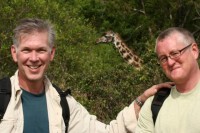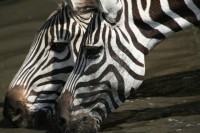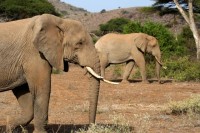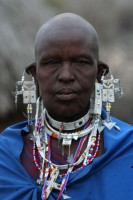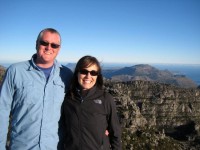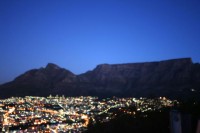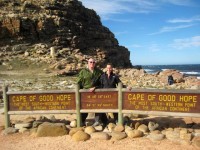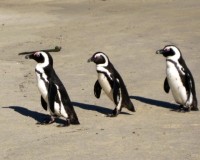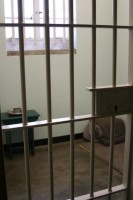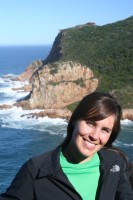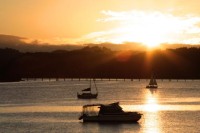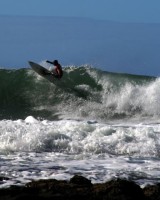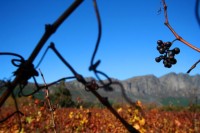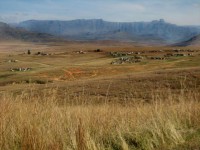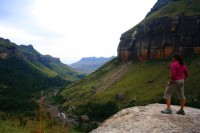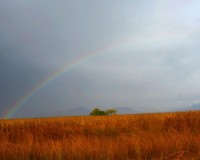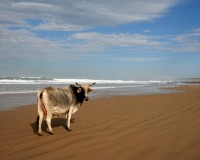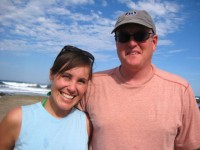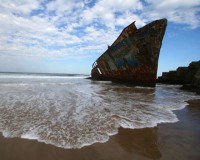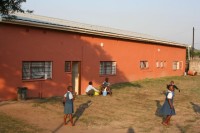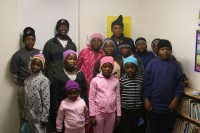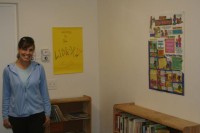Fri 27 Jun 2008
When One (Name Your Animal) Begins to Look Like Every Other (Name Your Animal)
Posted by Mike and Mindy Sontag under Tanzania
[3] Comments
THE FOLLOWING IS A GUEST BLOG BY MIKE AND MINDY SONTAG, TWO OF OUR CLOSE FRIENDS FROM NASHVILLE WHO MET US IN TANZANIA FOR A SAFARI:
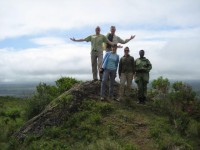
While seeing animals is fantastic, it can, at times, take on the quality of an exquisite art museum after having been to several exquisite art museums, where each painting of the Madonna appears like the last. With that said, however, you always seem to find some nuance in the animal viewing, much like each such painting has its own personal inspiration. In fact, we as a group and individually had several such instances along the way and came to expect – well – the unexpected.
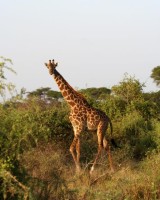
When we reached Arusha National Park after a long day a travel, the unexpected greeted us in the form of a gaggle of giraffes, two of whom were fighting for domination. We would spend the next two nights at the Hatari Lodge, which was built by Harvey Kruger, who starred in the John Wayne safari “classic,†Hatari. This was quite a change from the bush camp, with nine spacious bungalows, decorated in African art deco, each with its own fireplace.

Arusha Park is also known as “Giraffic Park†due to its large numbers of giraffe, which we saw in close proximity during a four-hour hike on nearby Mt. Meru. In order to take this hike, we had to employ an armed ranger to protect us in case we were threatened by any of the wild animals in the park. We were never aware of any danger as we walked among a family of giraffes, with their graceful strides and gentle faces, or as we hiked through a field with cape buffalo on one side and warthogs (which made Derek crave baby back ribs—they apparently taste like suckling pig) on the other.
We soon learned that taking such breaks from the “personal massager,†our guide’s nickname for the Land Cruiser (I would suggest personal “hell†might be more accurate), was important. We would, over the course of our safari, spend many an afternoon simply enjoying each other’s company instead of game viewing. With that said, during the next several days we had numerous instances of “unexpected†sightings of game that would reinvigorate us all from the monotony that game viewing can at times become.
Monkey Mayhem  – Each evening at sunset dozens of vervet monkeys would emerge from their jungle homes to create what can best be described as “monkey mayhem†by climbing on top of (and, if given the chance, inside and around) the nine bungalows at the Hatari Lodge.
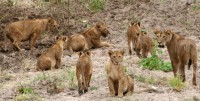
Born Free – Just as we thought another day would pass without spotting a big cat, we made our way through Tarangire National Park and noticed several vehicles, full of tourists with cameras and binoculars aplenty, parked alongside a dry river bed. We stopped and pulled out our binoculars. In the bushes across from us we saw a young lion eating a recent kill (a cape buffalo). As we scanned the area, we saw several lionesses lying in the dry river bed, then four young cubs playing in the grass close by. Then the papa lion, with his flowing mane, stood up from where he had been lying hidden in the tall grass and sauntered towards the lionesses. We had stumbled upon a pride of lions! We stayed there for an hour watching the cubs play with each other and then take a short break to run to mama and nurse as she lay stretched out in the grass. We saw the older lions take turns feeding on the kill, while the papa lion kept close watch over his family. Our guide, Lesika, told us it was rare to run across such a large pride (we counted about 12), feasting together on a recent kill.
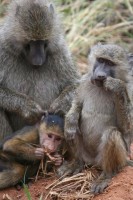
Monkey Mayhem Part Two – Now feeling as though one of our viewing missions was complete, we headed back to our lodge in the middle of the park. Before we made it there, though, we ran across a large clan of baboons, well over a hundred in number, crossing the road immediately in front of our vehicle and engaging in all sorts of curious acts, some that would make you blush.
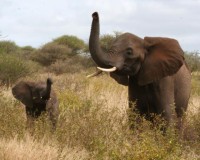
Charged By An Elephant – The next morning we began our journey to the Ngorongoro Crater. The trip began in spectacular fashion when we stopped to view an elephant family with two young elephants and apparently got a bit closer to the babies than the mother desired. She (all 8000 pounds of her) charged our car in spectacular fashion (all caught on video by Shanna).
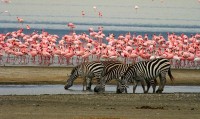
The Pink Flamingos of Lake Manyara – We spent a few hours seeking out animals in the area around Lake Manyara. The highlight of our time there was the chance to see the lake covered with what could easily have been fifty thousand pink flamingos.
We quickly learned while on safari to expect the unexpected and to savor the unique sightings that each day inevitably held.
[embedplusvideo height=”350″ width=”450″ editlink=”http://bit.ly/1r6iyyP” standard=”http://www.youtube.com/v/zIXbjUgCUvM?fs=1″ vars=”ytid=zIXbjUgCUvM&width=450&height=350&start=&stop=&rs=w&hd=0&autoplay=0&react=1&chapters=¬es=” id=”ep5067″ /]
[embedplusvideo height=”350″ width=”450″ editlink=”http://bit.ly/1r6iAH4″ standard=”http://www.youtube.com/v/Rew7U8bgCrM?fs=1″ vars=”ytid=Rew7U8bgCrM&width=450&height=350&start=&stop=&rs=w&hd=0&autoplay=0&react=1&chapters=¬es=” id=”ep7230″ /]
Google Video
